Let’s try to set the record straight.
More has been written about Kubrick – on his films, about his person, extracting his methods – than any other motion picture director in history. The Shining has in fact sparked a fervent cottage industry of books, blogs, and documentary films all to its own. There are dozens and dozens of fan sites in many different languages that measure into the thousands, if not hundreds of thousands, of pages. Some of it is pretty good. Most less so. And some off-the-wall kooky.
That he is the greatest American-born director ever is incontrovertible, and a extremely good case can be made he is the greatest director the world has ever seen in the 125 years of this industry (please read my post “The 10 reasons why Kubrick is the greatest film director ever” on Taste of Cinema.)
He is certainly the most controversial and galvanizing mainstream director, and everyone will have an opinion. He sparks interest. He changes the paradigm. He influences the world filmmaking, even 16 years after his death. His modern, dystopian, dynamic vision probably inspired more youngsters to pursue film directing than anyone else in the craft, for he showed us sights unseen and worlds unknown and unfathomable lower depths.
Kubrick was the first modern director of the post-Hayes Code era and kick-started the birth of a remarkable American filmmaking renaissance.
At no other time did the director’s craft reign so supreme than the 70s, and at no other time did so many great directors come to fruition and produce masterpiece after masterpiece – Woody Allen, Scorsese, Fosse, Ashby, Coppola, Spielberg, Altman, Herzog, Pakula, Roeg, Bunuel, and Ridley Scott, just to name a few. With the director as superstar, no one held back. Kubrick’s wild style gave them leave.
This era of unbridled creativity and unchecked expense ended, more or less, with the release of Michael Cimino’s Heaven’s Gate (1982), a film so expensive at the time (compared to earnings) it nearly bankrupted it’s small, director-focused studio – United Artists – and the ripple effect caused a major reshuffling amongst the power mongers. Directors were out or at least reeled in.
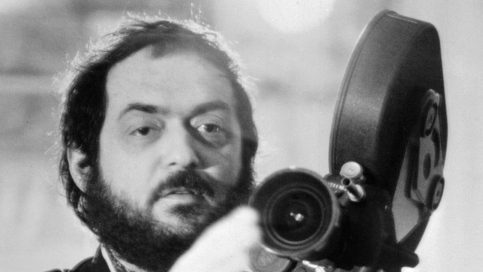
With fame comes baggage – a lot of it – part of the unintended consequence of being in demand was much written or speculated about Kubrick that was simply wrong or untrue. And much was written or speculated that turned out to be (somewhat) true years later!
Simply, Kubrick was different than anyone else, approached his craft different than anyone else, and directed films unlike anything anybody had ever seen. Kubrick’s quest for privacy while accomplishing all that, however well meaning and work-related, caused idle minds to broadcast loudly and write feverishly, turning fiction into gossip and gossip into truth, which was ultimately mythologized into a lonely, forlorn, man bereft of friends who made his films singlehandedly.
NOTHING could be further from the truth.
Here we will cherry pick some of the more interesting or infamous Kubrick mythologies – some points from the Internet as well as several of my own ideas and musings to keep it interesting and new – admittedly acknowledging this list is vastly incomplete and subject to my own predilections. Some items have less to do about discounting a rumor than elevating a directorial ‘tic’ into the realm of the mythological.
Kubrick was, for lack of a better analogy, “the most interesting man in the world,” a titan in his field, and an extremely intelligent, inquisitive person, not to mention a worthy leading light to the highest pantheon, who was not afraid to combine this intelligence and his obsessions into the making of his films.
That’s what makes him very unique and unusual in the annals of film history. Not bad for a youngster who showed little aptitude, barely graduated from High School if at all, left home at 17, never went to college except for a couple of courses and never, ever looked back.
As always, whether the category is mythological or real, the analysis and commentary are mine alone unless otherwise specifically referenced or footnoted.
1. Kubrick, bathroom fetishist
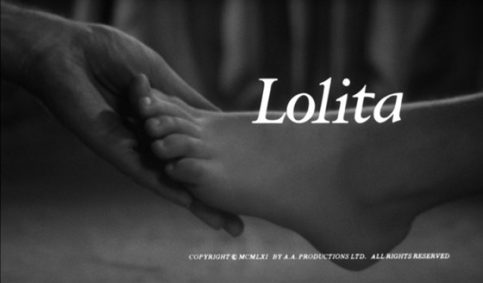
Kubrick is the master of cinematic fetishism.
His films exhibit such a wanton promiscuity that they can’t help but becoming cinematic porn for the cineaste than entertainment for the masses. Time and time again, Kubrick focuses on the grotesqueries of mankind and their bad habits. He never lost the zeal for the iconic image – the glory shot – that anchored his photographic essays.
His films became a series of glory shots and sensory overload. He shied away from nothing. The Kubrick stare and one-point perspective framing became his resume and aptly visualized his wicked, fetishistic sense of humor and ironic detachment. His film’s literary pretensions only increased his stock amongst his acolytes.
Many found this style frustrating in that Kubrick was less interested in story than the journey. This is important – the words are carefully chosen. Decades after his death, we realize now what genius this was.
Without a new Kubrick films to look forward to, which was always an event, we see now with the primrose gift of hindsight, how truly gifted – and unusual – he really was. His genius comes not from telling a story straightly but crookedly. Sidebars with any other director are whole themes with Kubrick. The stare becomes a cry. The straight angle becomes a cage. Camera movement becomes a malevolent fugue state. The repetition becomes a fetish.
From Spartacus on, many critical scenes have taken place in bathrooms. This obsession started early, in a way. As a young photographer working on a photo essay for Look, he had unlimited access to Rocky Graziano, the famous fighter. There is a shot of Rocky, naked, in the shower standing with his back partially toward the lens, his private area turned away, his look one of resigned fatigue.
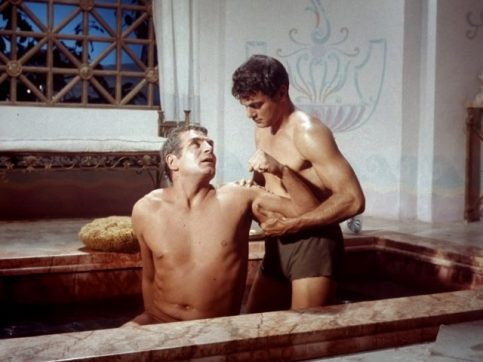
In films, the Hayes code – a self-regulated set of instructions –severely limited artistic license. Filmmakers were always pushing the limits most of the time without success. Occasionally, filmmakers could get away with bathroom suites and sometimes real bathrooms, like Hitchcock’s Psycho, which is the Holy Grail of Hayes Codes violations (it breaks 9 of the 10 precepts), accomplished, no doubt, by Hitchcock’s highly elevated stature in the industry.
Kubrick’s Spartacus, released the same year, pushed the envelope a little further and showed a provocative male-on-male scene between Tony Curtis and Laurence Olivier in the general’s private baths, the homoerotic overtones palpable. Much of the dialog, extremely suggestive but allegorical, where body parts were referred to as ‘oysters’ or ‘snails,’ was cut from its first release. It was later restored with Anthony Hopkins supplying Olivier’s voice (alas, the scene was found but not the audio.)
Lolita – the first for Kubrick – has actual scenes that take place in a real, live bathroom. James Mason as Humbert Humbert is sitting on a toilet (mostly shielded) in his robe to get away from his well-meaning but stifling wife. Dr. Strangelove virtually starts in the bathroom and later there is a suicide in one. 2001 famously made fun of the fetish with the posted “zero gravity toilet instructions” (which included details to take a shower.)
Alex gives himself away by reprising ‘Singing in the Rain’ while taking a bath in A Clockwork Orange. The Shining goes all in and proudly displays its art deco fetishism masquerading as metaphor. The film also has the greatest variety of toilets for a Kubrick film – 3.
There is Alice peeing in Eyes Wide Shut. Even A.I., later directed by Spielberg (but long-developed by Kubrick), has Monica peeing on the toilet while David, their new Mecha, explores his boundaries as a man-child and surprisingly opens the door, thinking he is playing a game.
But to me, there is something kingly and throne-like in the resplendent all-exposed porcelain-and-tile sanctum sanctorum from the Marine barracks on Parris Island in Full Metal Jacket Bathrooms a memory palaces were secrets are revealed, sex requested, identity repressed, and where people are killed.
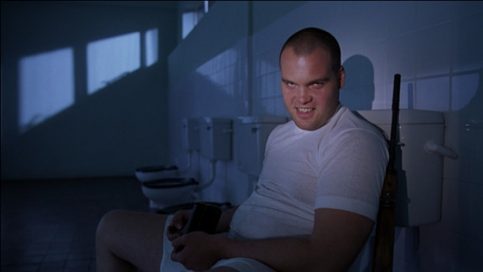
IMHO, psychologically, most of us think of the toilet as a sanctuary of sorts – a safe haven free from the flotsam of life. Equally, the space as an entity really does know all of our basest secrets as humans – we pee, we defecate, we vomit.
It is the Yin and Yang of any household. Hitchcock destroys this womb-like safety net in 60 seconds and with it, prophetically, our innocence. The 60s would never be the same. Filmmaking would never be the same and the Hayes Codes was increasingly abandoned and discarded altogether by 1968.
Kubrick’s use was more akin to semiotics, as symbols of communicative behavior, as places of the ultimate truth that have less to do with Oedipal obsessions than Faustian bargains that start and end in the bathroom. The bathroom gives us our release and, conversely, it is our cage, our solitary confinement, and woe to those that listen to their inner demons while confined within it.
What is most interesting is even though Hitchcock flaunted the Hayes Codes with almost religious abandon and perhaps was the original cinematic fetishist, his methodical, meticulous way couldn’t survive in its demise – total freedom was too much for someone who required rules and etiquette to deconstruct to produce drama. In an anything-goes society, those who required permission were out of a job.
After The Birds in 1963 and certainly by the late 60s he was eclipsed and out of fashion. It no small way, it was Kubrick who took up the Hitchcockian mantle (their largely cool, micromanaging style was very similar as are many other things which would take a book to explore.) Kubrick, rather new, still, and unafraid, unleashed his dyspeptic imagination on the world, and cinema was really never the same. Good bye, Hitchcock. Enter Kubrick.
2. Kubrick, the originator
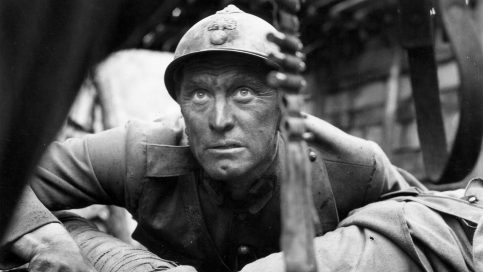
It’s been oft repeated he never made the same film twice. Well, that’s not quite true, strictly speaking.
While it is true he never repeated the same PLOT, he repeated the same GENRE pretty often. Directors get into a grove and they know what the want to do. Repetition of genre is pretty regular occurrence in the film industry.
Let’s chart out the genres:
- 1953 Fear and Desire – WAR
1955 Killer’s Kiss – CRIME
1956 The Killing – CRIME
1957 Paths of Glory – WAR
1960 Spartacus – WAR
1962 Lolita – DRAMA
1964 Dr. Strangelove – WAR
1968 2001: A Space Odyssey – SCI-FI
1971 A Clockwork Orange – SCI-FI
1975 Barry Lyndon – DRAMA
1980 The Shining – HORROR
1987 Full Metal Jacket – WAR
1999 Eyes Wide Shut – DRAMA
2001 A.I. Artificial Intelligence – SCI-FI (I include this because A.I. was to be his next film had he lived – pre-production was well on its way and a finished script was in hand.) - WAR = 5
SCI-FI = 3
DRAMA = 3
CRIME = 2
HORROR = 1
Charting it out, one can see Kubrick preferred certain genres to others. That WAR made the top of the list is unsurprising. It is one of Hollywood’s main staples, along with ACTION, ADVENTURE, COMEDY, CRIME, DRAMA, HISTORICAL, HORROR, MUSICAL, SCI FI, and WESTERNS.
Kubrick described his interest in WAR and CRIME films (over half of his output as a director) thusly: “…one of the attractions of a war or crime story is that it provides an almost unique opportunity to contrast an individual of our contemporary society with a solid framework of accepted value, which the audience becomes fully aware of, and which can be used as a counterpoint to a human, individual, emotional situation.
Further, war acts as a kind of hothouse for forced, quick breeding of attitudes and feelings. Attitudes crystallize and come out into the open.”
What is more surprising, perhaps, is what’s left out – boxing films (a sub-genre of DRAMA.) Kubrick loved to document boxers. They were part of his early photo essays and the main character from Killer’s Kiss was a boxer, not to mention Dave Bowman’s shadow boxing in the centrifuge of the Discovery spacecraft.
I hardly think those few instances thoroughly mined Kubrick’s thoughts and obsessions of the subject. Boxing films continue to this day to attract high-powered stars and directors. Still, it was interesting to find out, of all unproduced screenplays that remained as such, a boxing film was not among them.
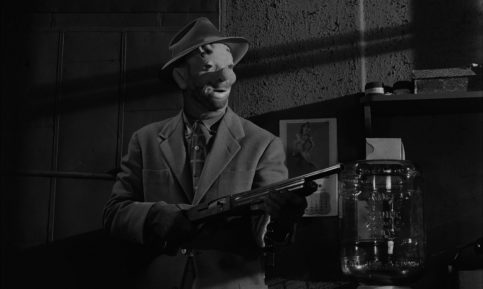
While Barry Lyndon is rightfully a DRAMA, it also features battle sequences of considerable heft. Indeed, Barry Lyndon’s very fortune rises and falls with whims and vicissitudes of battle, so I could, with some fudging, put it in WAR, increasing that category to 6, if I had the mind.
More appropriately, however, Barry Lyndon, Lolita, and Eyes Wide Shut – brothers and sisters to the sub-genre of LITERARY DRAMAS – a genre Kubrick was definitely drawn to time and time again in story development although most did not come to fruition.
Even though Kubrick had the freedom to make any film he wanted, he still had difficulty making any film he wanted! He left more unrealized projects are on the table than realized. And the 12-year absence of any films between Full Metal Jacket and Eyes Wide Shut is a mark difficult to comprehend.
Having written and made films, I know better than most that making movies is a very, very difficult. The stars really have to align and your idea has to flow cohesively and rather quickly, and a million other details have to be sorted out.
If not, a director can struggle for years trying to make it ‘work’ only to abandon after creative exhaustion sets in years later or a better project comes along. That is a lot of time lost. And if you go through several of those phases, as Kubrick did, years can turn into decades. Just ask Terrence Malick.
3. Kubrick, he giveth and he taketh
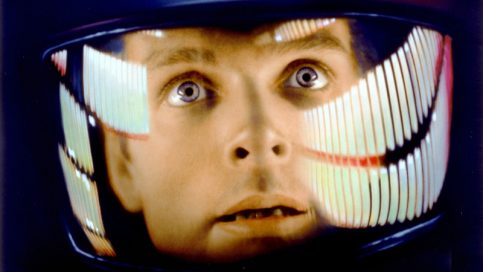
Kubrick, as we all know, had final cut status. Few realize it was much more than that. Not only did he have final cut up to wide release but also anytime thereafter as well. He also had final say over marketing campaigns and release schedules and the trailer itself.
He had authority over projection ratios and projection brightness and probably how much time elapsed between showings. And if something didn’t satisfy him in any of the reports he received from his in-the-field team, someone – usually the CEO – would get a call in the middle of the night.
Three days after 2001 was released in its roadshow format – an extremely limited, Cinerama release to just a few major cities, reserve seat engagement – Kubrick started to edit. Five days later, projectionists received very detailed instructions on what to cut and where, since new prints wouldn’t be available for a few days at best.
After he was done, he had cut 20 minutes. Long thought lost for 40 years to the editorial dustbin, the missing footage was found in a converted salt mine cold storage unit in Kansas. When 2001 premiered in April 2nd, 1968, it originally ran 160 minutes (2 hours, 40 minutes).
On April 9th, 1968, the film ran just shy 2 hours, 20 minutes. Actually, Kubrick was done there. For the general release, most 70mm and all 35mm prints, Kubrick eliminated the entrance music, the intermission and intermission music, and post-credit exit music. These music cues have all been restored for the DVD release. The missing 17-minutes remains unseen by the general public.
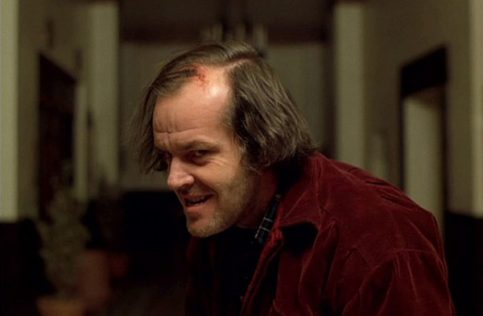
Even more famously, The Shining suffered a similar surgical strike even more extensive than 2001 which explicitly demonstrates what kind of power Kubrick yielded. If Kubrick thought it was going badly, he had the ability to change the paradigm. The US premiere of The Shining – this is hard to imagine now – was not very well received. 3 weeks into the US release he trimmed 2 minutes from the end – which honestly seems more obsessive-compulsive than helpful by that point.
Still receiving poor reviews, his changes for the European version were much more drastic – Kubrick cut an additional 31 minutes! And to top it off, Kubrick views the 113- minute European version, and not the 144-minute US version, as the superior cut.
Eyes Wide Shut was spared an almost certain destiny with editing scissors due to the director’s untimely death six days after its initial unveiling to studio chiefs. In a sense, it is an incomplete picture.
The studio, citing a contractual obligation to deliver an R-rated film, caved to MPAA-requested demands a re-cut to orgy sequence and, instead, inserted dark-robed digital human figures to obscure the sexually explicit nature of the acts for the US release which may or may not have been Kubrick’s desire at the time. Thankfully, a subsequent BluRay release restored the original intention.
The Kubrickian universe is fluid when it comes to changes after the fact. 2001 and The Shining are the most glaring examples. All directors tinker up until the last moment their contract allows and some even have power beyond it.
Would Eyes Wide Shut suffered similar cuts at the hand of the Master. Tradition and common sense emphatically says “yes!” There is an anecdote surfing the web that suggests Kubrick told Terry Semel, Warner Bros. studio chief at the time, that EWS was going to be 20 minutes shorter than what was screened that day. His death prevented any further tinkering, which most certainly would have tightened up a rather slow-moving, even ponderous – by Kubrick’s standards – film.
Gone, one would hope, would have been that absolutely unnecessary conversational reveal between Dr. Harford and Mr. Ziegler near the end of the film, and many other parts that seemed more ‘on-the-nose’ and expository than dramatic and insightful.
Based on history of cuts made on other Kubrick films (please search IMDb for a comprehensive list of ‘Alternate Versions’ on all of Kubrick’s films), we can see more often than not Kubrick cut the obviousness or repetitiveness out of the films in order to reemphasize the greater mystery inherent in the story.
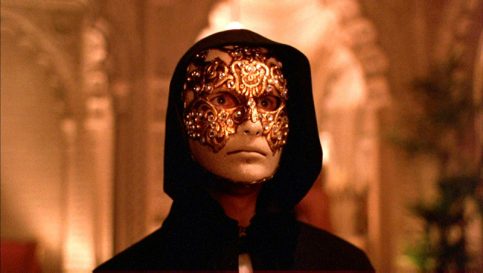
His attention to detail (to put it mildly) contributed to several, ignominious Guinness Book of World Records entries; Eyes Wide Shut, for instance, holds the record for the longest, continuous production – an unheard of 400 days!; and The Shining holds the record for the number of takes for a given scene – 127, as Shelley Duvall swings the bat at Jack Nicholson walking backward up the grand staircase (although rumor puts the scene where Scatman explains ‘shining’ at 140).
These are Wagnerian numbers who, as an operatic composer in pursuit of his own genius 100 years prior to Kubrick, wrote the longest mainstream opera in continuous repertory – Die Meistersinger (generally, 5 ¼ hours of music, not including intermission)– as well as the longest first act – also from Die Meistersinger (clocking in on average at 2 ½ hours).
Records aside, he was equally willing to cut scenes that didn’t work to make his artistic effort cleaner and leaner. And considering how much he saved of all of his other production material, Kubrick was especially cruel to his outtakes. Jan Harlan, Kubrick’s brother-in-law recalls Kubrick burning negatives to a number of his films.
This was also confirmed by Leon Vitali, Kubrick’s long-time assistant, also stated
“…we had thousands of cans of negative outtakes and print[s], which we had stored in an area at his house where we worked out of, which he personally supervised the loading of it to a truck and then I went down to a big industrial waste lot and burned it. That’s what he wanted.”
Curious.
4. Stanley Kubrick’s “Nazi” uncle-in-law
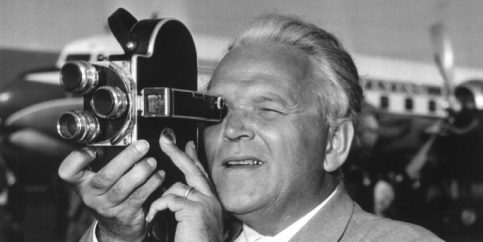
Yet another fascinating story behind the story.
Kubrick became part of the Harlan family lore when he married Christiane Susanne Harlan, the café singer that closes the film Paths of Glory. Her uncle was Veit Harlan, a very prolific filmmaker who directed many films for Hitler’s Third Reich propaganda campaign. His most famous film from that period is Jud Süß (1940, ‘Suss the Jew’). He was called “the baroque fascist,” and that he “…made the Reich’s loudest, most colorful and expensive films.” (Eric Rentschler “The Ministry of Illusion,” p. 167. ISBN 0-674-57640-3).
After the war he was tried for war crimes but ultimately found innocent of charges, insisting that even as director or writer, the Nazis were ultimately in charge of the content no matter what he said or did.
Harlan’s son, who himself became a writer and filmmaker, continued to defend his family’s name in a documentary called Wundkanal, (Wound Passage) and later in a memoir, Veit. Harlan – In the Shadow of Jew Süss is a documentary film from director Felix Moeller that continues this exploration of Veit Harlan and his descendants.
Veit, like another Third Reich documentarian – Helene Bertha Amalie “Leni” Riefenstahl – whom he certainly had to know personally, struggled with their artistic independence both during and after the war. During the Third Reich’s heyday, they plied their craft as best they could, saving their skins and protecting their respective families. After the war, hounded for their alleged beliefs, they had to save their skins all over again in the court of law.
It is important to realize – especially for Americans who haven’t lived under the rule of an invading country in 200 years – one does what one must to survive – one rarely has a choice. And, while it is almost certain all Nazis were Germans, it is absolutely incorrect to assume all Germans were Nazis or even believed in Hitler or supported the war except to pay it lip service.
Most Germans were not Jew haters or anything even approaching it and saw the oncoming winds of war as the worst possible outcome at the worst possible time for their beloved country now duped and ruled by someone whose only claim to fame was he could make a good speech.
So, was Veit Harlan a member of the party? I would think if they could conclusive prove he was that would have come out at his various trials. At the height of the war, Nazi membership was 8 million from a population of 70 million – or 12% at best. It is doubtful he was a member but he may have been repeatedly ask to join because of his high exposure in the arts.
A funny anecdote: Christiane Kubrick, when asked about her past, has said when Stanley Kubrick, her Jewish-born husband, was to first meet her infamous, filmmaking uncle, he had to drink a “big glass of vodka” to calm his fear. I suspect this had more to do with the fact her uncle was also a famous director and less to do with politics.
What would I give to have been a fly on that wall! As for Kubrick, he kept his politics and Jewishness close to his chest his entire life.
5. Kubrick, the Packrat
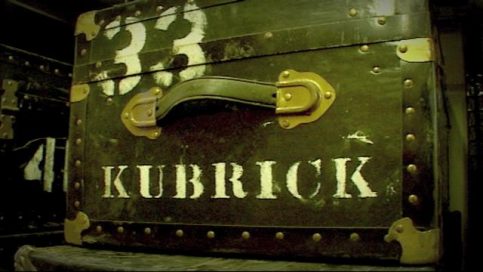
Apparently, no one outside of his inner circle knew this. And, if they did they certainly didn’t talk about it much, if at all.
Only after his death did this fact became widely known, and the extreme American Hoarders-level extent of his collection was an absolute stunner of a reveal. Great for film historians, bad for the individuals who had to maintain and catalog it.
Jon Ronson’s 2008 documentary Stanley Kubrick’s Boxes unboxes some of the mountains of memorabilia Stanley left behind following his death and details some of his findings. For the first time, after only perhaps the barest hints and rumors, did we learn Kubrick was a packrat!
And not only a packrat but also an absolutely eccentric one at that! And not only an eccentric one, but on a scale approaching epic! What separates him from the typical hoarder was the way it was saved, quantified, and cataloged for easy cross-referencing and findable.
Everything – every production note, photograph, hate mail, prop and on and on and on was cataloged, boxed, and stored. After learning this, my heart was warmed. Kubrick was human after all, and his behavior somehow affirmed my own massive collections of books and data as being ‘normal’ and what artists do because that’s the way they work.
If Kubrick’s eccentricities are the source of his genius, what does that really say about the nature of genius? I have long believed geniuses are, by their very nature, vastly different from the rest of us and manifest their eccentricities in peculiar, often misunderstood ways. Their quirks give them leave to create, and in the creating genius is made, and in the genius worlds change.
This essay is a celebration of the quixotic nature of genius, how it relates to our own patterns and behaviors, and how it manifests into our art, and how myth both feeds and nurtures the subconscious of our creativity.
6. Kubrick, the NASA employee
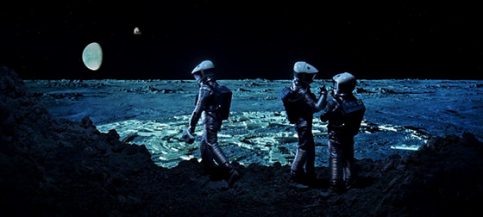
As much as I’d like to believe the essence of this myth – Capricorn One is one of my favorite guilty pleasures after all – I am sorry to report that the moon landings are real and Kubrick was not the director of them or ever even a NASA employee – although he did borrow their lenses from time to time!
During its heyday in the 60s, NASA employed hundreds of thousands of individuals across thousands of separate companies both large and small on a scale similar to the mobilization of WWII to accomplish their goals. Not only did NASA go to the moon once, they went FIVE MORE TIMES! I ask anyone, if it was faked – and it’s hard enough to do it once and keep the secret – why go again, and again, and again?
The rumor that Stanley Kubrick was involved came long after the landings were completed and after the release of The Shining where some saw an alleged Apollo moon-landing apology sewn into the symbolism and semiotics of the film. The believers point to the blue sweater worn by Danny that showed a rocket with the word ‘Apollo’ on it. Of course, this is utter nonsense but I suppose that’s part of the fanboy fun of it.
Most of the movie-going public is unaware of most of the random serendipity that happens on set during principal photography. Even though the Internet has allowed the flood tide of trivia and anecdotal intrigue to proliferate, it’s important to understand that, for most of film’s history, film production was rather secretive or not terribly exciting, and scant details got out unless it (usually) concerned the star itself.
The director was an unheard-of cog, mostly. The reality is various needs from any of the designers crop up constantly and without relief until the final shot from wardrobe to set decorator to cinematographer to the director suddenly changing his mind and demanding everything new.
In this case, Kubrick wanted a sweater – a late request because the others didn’t look convincing enough or age-appropriate. Needing a sweater, Milena Canonero, the costume designer on The Shining remembered a sweater her friend had recently knitted. She showed it to Kubrick and the next day it was in the shot. There you have it! As simple as that.
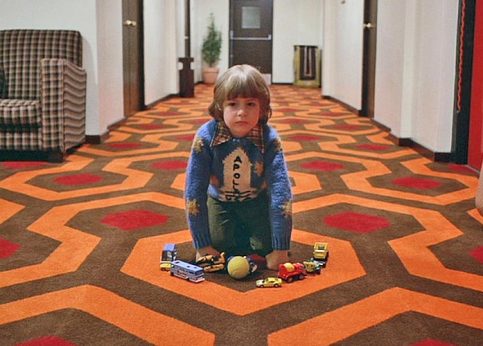
The Shining and the sweater was not a premeditated apology to the American people and the world that the moon landing was faked and directed by Stanley Kubrick. It was simply a random request fulfilled the day before shooting, picked from a friend’s closet.
Okay, the fact that Kubrick’s last film, Eyes Wide Shut, was released on the July 16th, 1999 – exactly 30 years to the day after Apollo 11 launched from Cape Canaveral will be a harder one to explain!
7. Kubrick, the recluse
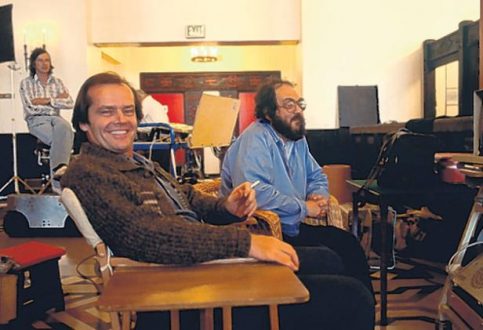
Kubrick was well known and available to those who needed him. He was never, ever, any kind of hermit. True, he did not grant too many interviews over the years but, while he was making a movie, he was consumed and quite busy. Since his shoots and post-production normally last years, that’s a lot of time away from the public eye.
In fact, other than shooting on location or at a studio, all pre- and post-production was performed at his estate. He rarely left it unless shooting. His vast armies of production assistants scoured the world and took thousands of pictures and collated mountains of data and historical research.
Kubrick’s main tool of communication was the phone and fax. He was on the phone constantly with experts, filmmakers, production experts, his producers, who would receive calls at all hours of the evening at all times of the year.
The truth is, he preferred being surrounded by and encapsulated within his large, English country estate adorned by his family, friends, working associates, and many, many animals. He was especially fond of cats and it gave him peace. The lack of travel time to and from a ‘normal’ office meant more time thinking and making films.
Kubrick, discussing his work habits:
“As much as there are hours in the day, and days in the week. I think about a film almost continuously. I try to visualize it and I try to work out every conceivable variation of ideas which might exist with respect to the various scenes, but I have found that when you come down to the day the scene is going to be shot and you arrive on the location with the actors, having had the experience of already seeing some of the scenes shot, somehow it’s always different.
You find out that you have not really explored the scene to it’ fullest extent. You may have been thinking about it incorrectly, or you may simply not have discovered one of the variations which now in context with everything else that you have shot is simply better than anything you had previously thought of.
The reality of the final moment, just before shooting, is so powerful that all previous analysis must yield before the impressions you receive under these circumstances, and unless you use this feedback to your positive advantage, unless adjust to it, adapt to it and accept the times terrifying weaknesses it can expose, you can never realize the most out of your film.”
Michael Herr:
“He was in fact a complete failure as a recluse, unless you believe that a recluse is someone who seldom leaves his house… he was one of the most gregarious men I ever knew, and it didn’t change anything that most of this conviviality went on over the phone.”
Hardly the recluse. Always working. Always questioning. Always looking for answers.
8. Stanley “everything in Room 237 is true” Kubrick
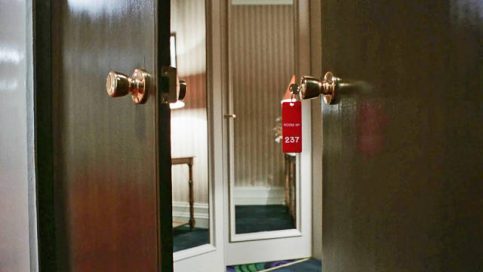
Stanley Kubrick never said that line – and wouldn’t – even if he could.
But, O, imagine the possibilities! Imagine he looked at the film Room 237 and said, ‘for once, someone got it right!’
“Room 237” is a must-see film for the simple reason to see how monumentally, spectacularly, gloriously wrong some people can be when it comes to film analysis.
Please don’t misunderstand me – all analysis and investigation is merited, and “Room 237” wins the award for reaching the highest and farthest I’ve ever witnessed. No one can deny the film or the interviewee’s enthusiasm for their beloved subject matter and the film often surprises in unexpected ways.
Again, I enjoyed the film immensely, and I would encourage any fan to watch. There are a number of other features in the documentary that really round out the picture. There is a two-disk BluRay version for the geekiest of geeks (which I happen to own!)
- The major theories proposed in Room 237:
A. The Shining is about the genocide of Native Americans, because there is imagery throughout the film associated with the American West.
B. The Shining reveals, once and for all, that Stanley Kubrick had directed and produced the footage for NASA to publicize the Apollo 11 moon landing
C. The Overlook’s labyrinth connects The Shining to the mythic story of the Minotaur
D. The Shining is a feature-film-length metaphor for the Holocaust
E. There is a long section that features The Shining run forward and backward and superimposed, which brings different juxtapositions into play.
I’ve already addressed the issue of the Apollo moon-landing elsewhere in this article. As for the other suppositions in Room 237, Leon Vitali, actor in several Kubrick films and assistant to Kubrick for over 20 years, and present on set during the entire 15-month shoot of The Shining, refutes each and every point the film makes, in a good-natured way, of course. Most of the time, he iterates, the versatile, shifting, ever-dynamic process of making a movie dictated what was used or said.
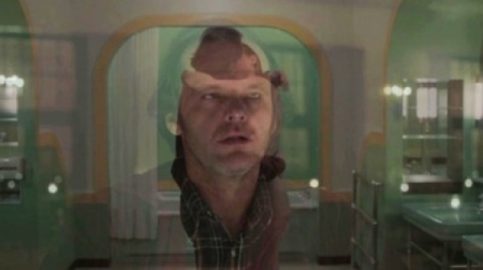
Like the serendipitous moment when McDowell improvised the song Singing in the Rain in A Clockwork Orange, The Shining had its share too. Many lines were improvised on set or hastily written and rehearsed moments before shooting, such as the Big Bad Wolf recitation – not because Kubrick wanted to draw attention to the Holocaust.
Calumet baking soda was used because all, if not most, hotels in American use the product and can be seen in every hotel pantry – not because Kubrick was trying to draw attention to the plight of the American Indian. As for the Minotaur allusions, Leon has this to say:
“That astonished me…I stood staring at all that stuff for weeks while we were shooting in that room. It’s a downhill skier. It’s a downhill skier! It’s not a Minotaur.”
The eeriest theory – and coolest – superimposes the film on top of each other – one strip running forward, the other strip running backwards. Some extremely prophetic and powerful visual juxtapositions ensue – in true homage to Sergei Eisenstein, one of Kubrick’s cinematic heroes, whose name is curiously absent from the narrator’s discussion. So perfect are some of the overlaps that for a moment – just for a moment – one almost believes the structure was intentional and premeditated.
The Shining, more than any other Kubrick film outside 2001, perhaps, sparked an astonishing cottage industry of close readings and abstract analysis. Having seen or read a great deal of it, I would say most of this analysis is extreme over-reach. They fail to take into account the vagaries film production, especially continuity errors, and reality.
Speaking of the issue of making films, he once said:
“I think it was Joyce who observed that accidents are the portals to discovery. Well, that’s certainly true in making films. And perhaps in much the same way, there is an aspect of filmmaking which can be compared to a sporting contest. You can start with a game plan but depending on where the ball bounces and where the other side happens to be, opportunities and problems arise which can only be effectively dealt with at that very moment.”
9. Stanley’s first film: or how I learned to stop worrying and loved Fear and Desire
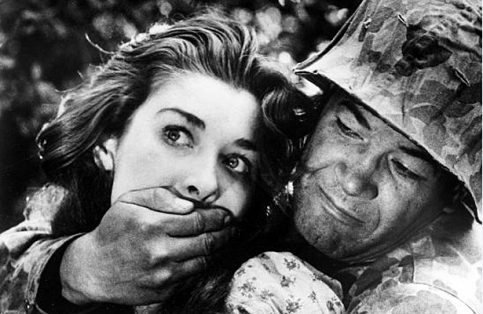
Calling his first film a “bumbling amateur film exercise,” Kubrick attempted to buy back or retrieve every single copy of Fear and Desire he could lay his hands on. That part is very much true. The early behavior would set precedent and manifest into much larger efforts to control his product later in his directorial life. He was quite successful in pulling A Clockwork Orange from distribution in the UK, and efforts to re-edit The Shining are well documented.
Clearly he was an artist always in flux, always thinking, always wanting to better his “brand.” And yes, Kubrick is a “brand” as sure as Coca-Cola or Andy Warhol or Hitchcock are brands… and brands need protection from outside influences. The larger issue is when is enough enough? When do you reach the point of diminishing returns? The fact that he was able to achieve his goal and exert this power makes him one of the true elite film directors both as an artist and businessman.
Whether his edits changed anything or not from the public point of view is not really the issue. And questions like “If Eyes Wide Shut was 20-minutes shorter would more people have considered it a better film?” or more importantly, “…would more people have seen it?” are moot. The exertion of Artistic Power – whether is makes sense or not – is the point. Artists do because they can.
As far as Fear and Desire is concerned, thankfully he fell short of his goal. The Museum of Modern Art, for instance, held on to several 16mm & 35mm prints that could be seen privately at any time with the right credentials. Now, 62 years later, the film can be seen on Apple iTunes and DVDs popularly circulate in a wide release and a new 4K master. What would Kubrick think?
Personally, I think the film deserves its resurrection.
We reveal a lot of ourselves in our first films because the Hollywood mantra has always been, “write what you know” – and most people ‘know’ themselves, or their interior thoughts and longings, best. Director’s first films are the big reveal to a great career, or at least to great ideas. (In Hollywood, it’s the second film that really counts – sustainability is key – and if you could pull off the double your career is assured.)
Few ‘first films’ survive from that directorial era, believe it or not. Kubrick did not go to film school so his first effort was a 1-hr featurette financed by his uncle, written quickly, on subjects and interests he could reel off without thinking too much, shot in way to minimize costs with long, expository scenes of dialog; little but explosive action; and an ironic, detached ending. Clearly, his films changed very little!
Spielberg and Lucas’ first films survive and are quite famous. Lucas’ film – THX-1138 (1971) – was quickly picked up and expanded into a full-length feature film and promptly became a masterpiece, hot on the heels of A Clockwork Orange, also released that same year. Orson Welles’ first film looks almost experimental, his identifying self-deprecating humor an essential aspect to his oeuvre even at a young age.
But Kubrick’s effort was deeply psychological and serious. Its dialog humorless but imaginative and intellectually probing. Its cinematography striking. His second film and first full-length feature – Killer’s Kiss – was even more accomplished.
But Fear and Desire started it all and shot for next to nothing with migrant workers as crew and Kubrick doing most everything else (as most student film directors do!) It revealed a budding talent aching to break out into the real world. The fledgling effort got noticed. Variety called it “a literate, unhackneyed war drama, outstanding for its fresh camera treatment and poetic dialog.”
By today’s standards, the existential drama is a bit ‘on the nose’ (an industry term meaning ‘obvious and lacking subtext) but distinguishing in many other ways.
It’s was scary how the film mimicked the style of the rest of his career. What was also clear is one of Look’s greatest still photographers now had a new career.
10. Kubrick – learn to say it right!
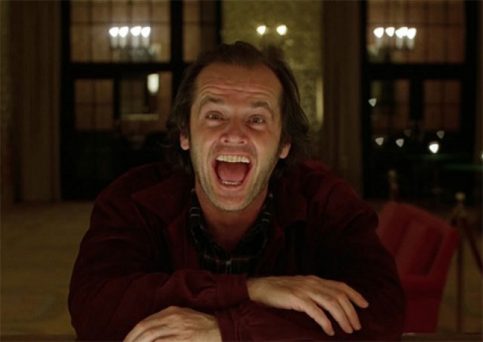
It’s pronounced Cue-brick, not Koo-brick.
CONCLUSION
So, how did a Porsche-driving, football-helmet-wearing hermitgeniuscontrolfreak, who wouldn’t fly and wouldn’t allow his chauffer drive over 30-mile-per-hour, who barely finished high school, who loved cats and all sorts of other four-leggeds and was surrounded by women at home, ever become the greatest filmmaker to have ever lived?
Good question. Shakespeare had a word or two to say about greatness:
Malvolio, Twelfth Night (II, v, 156-159)
Be not afraid of greatness: some are born great, some achieve greatness, and
some have greatness thrust upon ‘em.Macbeth, Macbeth Act 1, scene 7. 25–28
I have no spur
To prick the sides of my intent, but only
Vaulting ambition, which o’erleaps itself,
And falls on th’other. . . .
The fact is, a rumor repeated 12 times develops a life of it own. They ticky personal myths are small truths grown into much larger fiction on steroids. They didn’t happen – or at least not the way most of us would like to remember or relate. We all like a good story. Truth is incidental.
John Ford, one of the great American filmmakers, knew this too. In fact, he crafted an entire film around mythology and truth. The film is The Man Who Shot Liberty Valance. In it, a newspaper editor says:“This is the West, sir. When the legend becomes fact, print the legend.” And so it is with Kubrick.
by Mark Krasselt

You must be logged in to post a comment Login